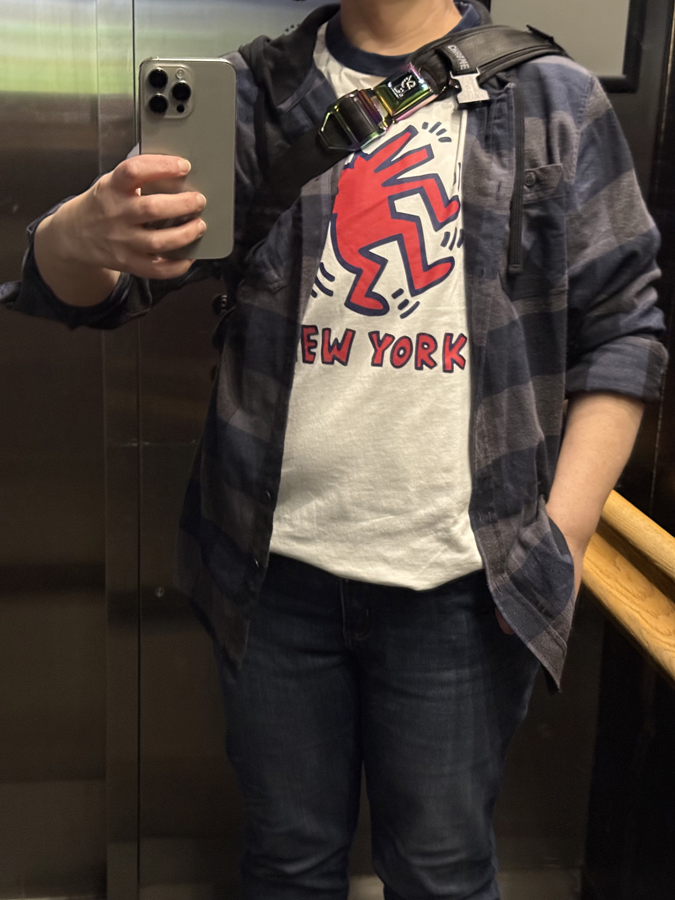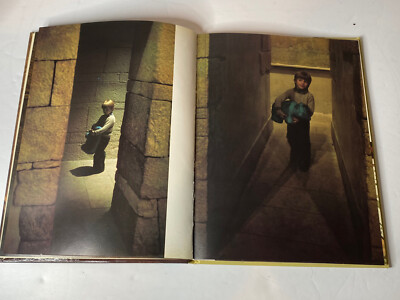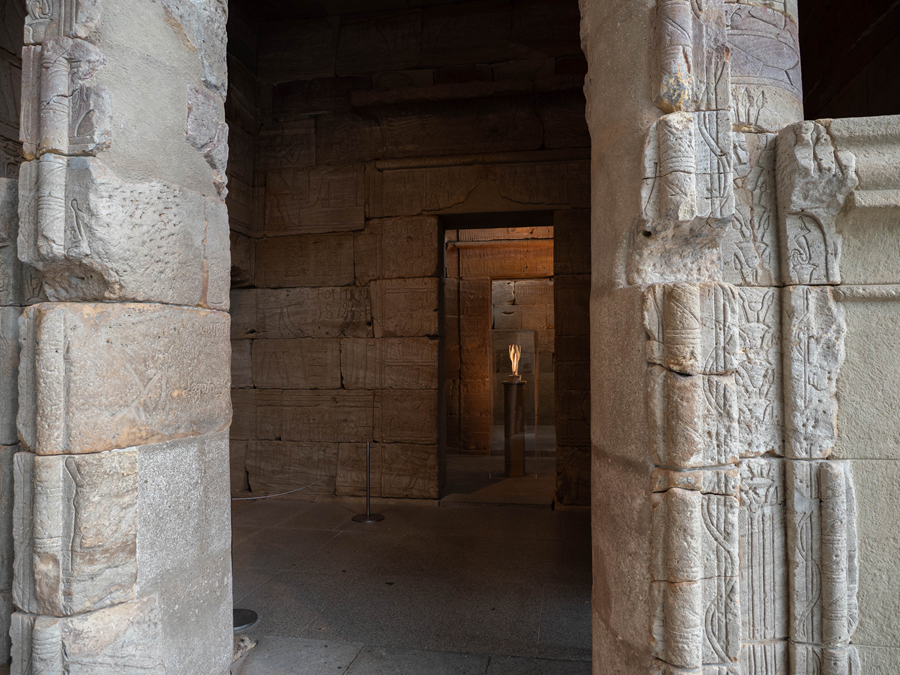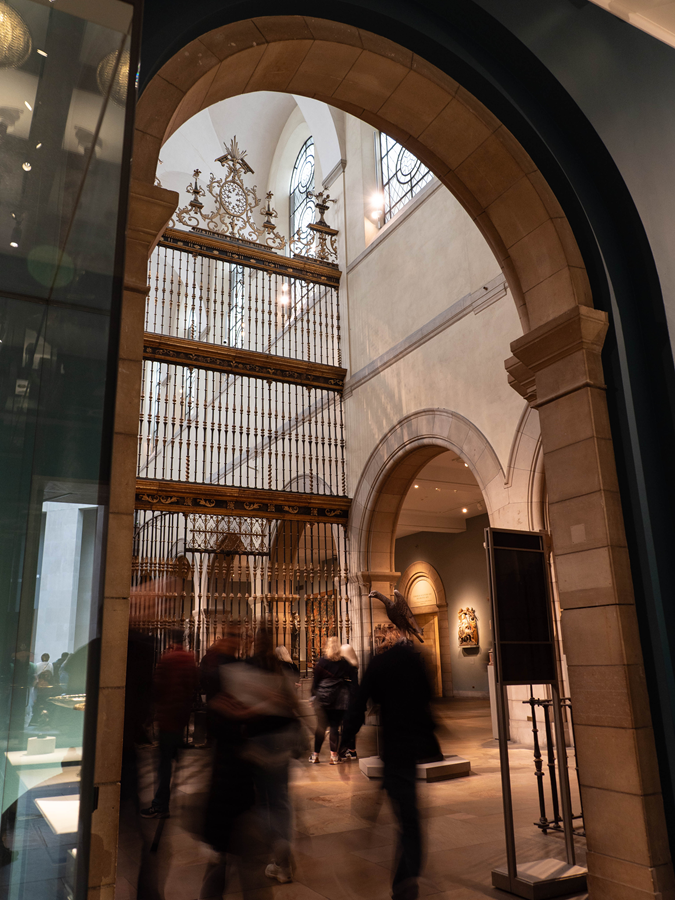Oliver Moss (![[personal profile]](https://www.dreamwidth.org/img/silk/identity/user.png) olivermoss) wrote2025-05-01 09:23 pm
olivermoss) wrote2025-05-01 09:23 pm
Entry tags:
NYC Trip Day 6 - The Met
It was my last day in NYC and I wasn't sure if I wanted to go anything in particular or just wander. When I am in cities, I am mostly wandering and not doing museums and things like that. It felt weird to not be spending time just exploring. But, I decided to go because of William. William is a small turquoise blue hippo that's the Met's mascot. I had a kid's book of him and couldn't resist buying a small plush William in the gift shop of the Cloisters. To have him and never go? That would be odd.
My fit for a day at a museum in NYC:

The book I had as a kid that was my exposure to The Met and it's collections was called A Tale of Two Williams. It's about a kid who doesn't want to go to the museum, but his mom drags him there. He finds a sentient, talking creature chained to a wall and agrees to free it. In exchange William the Hippo shows William the Little Boy around the museum, except no on else is there and the pictures were clearly taken at night. So, it's a kid and this creature wandering around Egyptian tombs at night. I wasn't able to find many pictures of the book, but here are a few:


Which brings me to my question...
I spent a lot of time with that book as a kid, copying the hieroglyphics over and over, because I wanted to learn Egyptian. I was a kid, the internet didn't exist, that book is what I had, so I filled pages and pages.
It's weird that I'd never been to the Met. In school we never did field trips to the NYC museums, the schools assumed we'd all been and often. Instead we went to museums that were hours in the other direction, often small niche ones, or went to artist's studios. Honestly, pretty impressive on the part of my schools. But, when I'd say I'd never been people were confused by it. In middle school I wrote an assigned essay on why museums like the Met are propaganda trying to shape America's concept of itself. I'd read and written about it, teachers again assuming we'd all had the experiences of being there and they were helping us engage with it. In front of the museum is a new courtyard with fountains, gifts of David Koch and very controversial attempt to buy legacy. Reading about it doesn't capture the weight of it, both the massive open galleries and the tightly packed mezzanine levels. As with the Cloisters, I was less interesting in the art and more in it being there and how it was displayed.
A room that was scooped up to moved to America so Americans could look at it:

There are a number of displays at the Met that are rooms. Some are like 'we have a bunch of furniture and stuff from the era and here is how a room could have looked' and some of it is like 'we liked this bedroom/dining room so we took it to go'
Then there's this:


Then you head up into the crowded balcony and mezzanine areas and:

Also, I did a thing, or tried to do a thing: youtube short of a zoom out in the area Wish I could embed shorts like other youtube videos. Anyway, I loved spending time there and eating fruit cups on the balcony. I know I sound very critical of museums, and I am, but they are also amazing and I still enjoy them and get a lot out of them. The Met is just so massive and weighty.





Sections of mummy wrappings:

That display is amazing. If I could get a larger pic without all those reflections, I'd maybe put a print out on my wall. The Met has a certain approach to displaying art and there is something about that modernist 'neutrality' to displaying some of the art that fascinates me. Also, the brown shades were cool.
I spent ages in there and this doesn't even begin to touch on many of the galleries I saw, or the weird liminality of the corridors. There was a an early photography exhibit I loved, but that could be a whole post on it's own. I could, and might, do a post on seeing people there looking at stuff from their own heritage. But this post has gotten long enough!
My fit for a day at a museum in NYC:

The book I had as a kid that was my exposure to The Met and it's collections was called A Tale of Two Williams. It's about a kid who doesn't want to go to the museum, but his mom drags him there. He finds a sentient, talking creature chained to a wall and agrees to free it. In exchange William the Hippo shows William the Little Boy around the museum, except no on else is there and the pictures were clearly taken at night. So, it's a kid and this creature wandering around Egyptian tombs at night. I wasn't able to find many pictures of the book, but here are a few:


Which brings me to my question...
Open to: Registered Users, detailed results viewable to: All, participants: 4
Is this book a
I spent a lot of time with that book as a kid, copying the hieroglyphics over and over, because I wanted to learn Egyptian. I was a kid, the internet didn't exist, that book is what I had, so I filled pages and pages.
It's weird that I'd never been to the Met. In school we never did field trips to the NYC museums, the schools assumed we'd all been and often. Instead we went to museums that were hours in the other direction, often small niche ones, or went to artist's studios. Honestly, pretty impressive on the part of my schools. But, when I'd say I'd never been people were confused by it. In middle school I wrote an assigned essay on why museums like the Met are propaganda trying to shape America's concept of itself. I'd read and written about it, teachers again assuming we'd all had the experiences of being there and they were helping us engage with it. In front of the museum is a new courtyard with fountains, gifts of David Koch and very controversial attempt to buy legacy. Reading about it doesn't capture the weight of it, both the massive open galleries and the tightly packed mezzanine levels. As with the Cloisters, I was less interesting in the art and more in it being there and how it was displayed.
A room that was scooped up to moved to America so Americans could look at it:

There are a number of displays at the Met that are rooms. Some are like 'we have a bunch of furniture and stuff from the era and here is how a room could have looked' and some of it is like 'we liked this bedroom/dining room so we took it to go'
Then there's this:


Then you head up into the crowded balcony and mezzanine areas and:

Also, I did a thing, or tried to do a thing: youtube short of a zoom out in the area Wish I could embed shorts like other youtube videos. Anyway, I loved spending time there and eating fruit cups on the balcony. I know I sound very critical of museums, and I am, but they are also amazing and I still enjoy them and get a lot out of them. The Met is just so massive and weighty.





Sections of mummy wrappings:

That display is amazing. If I could get a larger pic without all those reflections, I'd maybe put a print out on my wall. The Met has a certain approach to displaying art and there is something about that modernist 'neutrality' to displaying some of the art that fascinates me. Also, the brown shades were cool.
I spent ages in there and this doesn't even begin to touch on many of the galleries I saw, or the weird liminality of the corridors. There was a an early photography exhibit I loved, but that could be a whole post on it's own. I could, and might, do a post on seeing people there looking at stuff from their own heritage. But this post has gotten long enough!
no subject
no subject
I saw a number of people there seeing stuff from their own cultures and that was interesting. For Chinese Americans, for example, that can be important. But it struck me that if I am seeing stuff from my heritage, it's in spaces controlled by my demographic. The New York banker set / trends of the art world / etc isn't interested in Norwegian art, they often don't consider it art. When I see exhibits on art, craft, artifacts, etc from Norway it's in Norwegian heritage centers.
The Met has stuff from The Netherlands and Denmark, because of porcelain, Dutch Blue, Danish Modern and all that. But Norway and Sweden? The one painting these museums might even want is in an Oslo museum (The Scream, Edvard Munch)
I did one museum studies course in college, but also I've always been interested in this sort of stuff, even if most museums don't necessarily interest me.
no subject
But yeah, there are also a lot of cultures that just get lumped together. Like maybe there's a "Scandinavian" display, but it's likely to include the sorts of things you mentioned, like some Delft Blue, and treat it as if it's representative of a whole region... ignoring that all of the countries and cultures in that region are distinct and not actually interchangeable.
(Alex has a few friends in Norway, so he's always on the look out for Norwegian things, so that is a specific lack that I've noticed!)
no subject
I was surprised to hear people looking at an Ancient Greece display talk because I realized, they were likely Greek. Ancient Greek and Roman (and Egyptian, but that's a whole 'nother thing) history is kinda treated in weird ways like it belongs to the world. Even I was like 'oh, right, this is actually their direct heritage'.
Both Portland and Seattle have specifically Scandinavian museums. It's the Portland one that arranged the Olle Bolle troll statue. And again, it's by my demographic and for my demographic. It's a very different thing to have museums like that.
no subject
Truth about Greek and Roman stuff, as well as Egyptian. It all seems to be treated as a "global" history in a way that most other cultures aren't. (Egyptian is a whole thing... our natural history museum got rid of the Native American exhibits, because they decided it was inappropriate to have human cultures displayed that way... but they still have an Egyptian section.)
A museum by and for the demographic that it's also about is a very different thing, for sure! I wish there were more museums that had that sort of focus.
no subject
Having modern Native artists is important because we talk about Native people in the past tense so much. Like, they still exist. Some are even members of our community, and so many people either don't get that on an emotional level or they just like their ear gets used to certain conjugations around talking about Native people and they repeat the past tense thing without realizing it.
British history is entrenched in the idea that they are the heirs of the power of the Roman Empire. Some Arthurian stuff is based on the idea that the power of his reign was being of their line. And people being weird about Egypt and Ancient Egypt is a whole, massive thing.
More museums like the Nordic Heritage ones would be great. The weird combination of being disregarded but also Scandi immigrants were (massive generalization here) mostly mostly comparatively privileged, so we kinda just did our own thing. We weren't chased here by the law, famine, religious stuff, etc.
no subject
The Smithsonian does have the benefit of being able to shuffle things between museums at least, and I'm glad they've corrected a lot of the way things were displayed and treated in the past.
Right? There's so much of an attitude about the Native Americans being this past tense thing, like yes, they were here way back when, but now they're all just mysteriously gone. When... no! Still here! It's really uncomfortable to encounter that attitude in so many places, and that's of course part of the baggage with any sort of museum exhibit.
I guess with the Roman stuff it does make *some* sense, because they were such an extensive empire. Their history does overlap with the history of the lands they held. Though the British emphasis on some sort of almost "continuity" with the Roman Empire is a little... strange.
Fetishizing Ancient Egypt is a whole massive thing for sure. Not to say I didn't have a phase where I was super into it as an elementary schooler, either... just that it has a really weird place in the cultural consciousness. People are SO WEIRD about it, though.
There are a lot of really different experiences in different immigrant cultures, and a lot of it is definitely "did you want to come here, or were you forced to either literally or by circumstance?" But I'd really like to see more museums in general that are created by the groups in question.